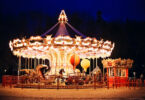The road to the White House for many U.S. presidents ranged from meager farmhouses to palatial estates until they finally reached 1600 Pennsylvania Avenue. But, did you know that it’s possible to visit some of the houses where they grew up back when were just regular US citizens? Join us on this trip through Presidents’ homes you can visit, and be ready to take a look into the more personal side of those who once ruled the free world!
The Lincoln Home — Springfield, Illinois
Located at Eighth and Jackson in Springfield, Illinois, Abraham Lincoln and his family occupied this Greek Revival home from 1844 to 1861. Lincoln bought the home from the Reverend Charles Dresser, the very man who married honest Abe and his wife Mary Todd. Handing over $1,500 for the home, Lincoln would remodel the house several times throughout his stay, even adding on its second story. It was here Abraham Lincoln left for the White House in 1861.
Clinton House Museum — Fayetteville, Arkansas
President Bill Clinton took then girlfriend Hilary Rodham past this tiny brick bungalow home in Fayetteville, Arkansas on the way to dropping her off at the airport. He was a law professor at the University of Arkansas at the time. After a comment she made about how pretty it was, Clinton bought the home on a modest salary, telling Hilary that she had to marry him now. She did in the Clinton House Museum’s very living room. The one bedroom home contains displays of early speeches and campaign memorabilia along with a replica of Hilary’s wedding dress. 17 years after their marriage in that ordinary living room, Bill would be elected president of the United States.
George Washington’s Mount Vernon

Mount Vernon is one of the most austere and impressive presidential homes. Inherited by Washington in 1754, the man who would become the first president and the Father of the United States spent 45 long years turning Mount Vernon into a grand estate. Located a short distance from Washington, D.C. in Alexandria, Virginia, Mount Vernon exudes Washington’s influence from the estate’s regal gardens to its 21-room mansion. Tours of the site cover a variety of topics, including a detailed analysis of Washington’s life and even how people lived in the 18th Century. Interestingly, Washington’s love for Mount Vernon and his desire to return to the estate led him to decline a third term, establishing a major precedent in American politics.
The Truman Farm — Grandview, Missouri
Harry Truman gave up a $100 a month salary at a bank to go work on the family farm, milking cows and dealing with no plumbing or electricity. Truman spent 11 years on the farm in Grandview, a humble home that he shared with his grandmother, parents, sister and brother. The farmhouse can still be visited today and it’s surrounding 10 acres.
Thomas Jefferson’s Monticello

Monticello is both a historical and architectural wonder as the home of the third president and writer of the Declaration of Independence, Thomas Jefferson. Located in the middle of the spectacular Blue Ridge Mountains in Charlottesville, Virginia, Jefferson began construction on Monticello in 1769 and continued altering the home until his death on July 4, 1826. Tourists visiting Monticello have a variety of options on how to spend their day, including tours of the fabled mansion itself and tours of Monticello’s history of slavery. Those who visited the site in the past, however, recommend buying a premium pass for tours of the second and third floor. While pricey at $67 a person, Monticello’s premium tours allow visitors the opportunity to visit the estate’s famed Dome Room and even the bedroom where Jefferson died at the age of 83.
Ash Lawn-Highland — Charlottesville, Virginia
With neighbors like Monticello and Montpelier, James Monroe’s Ash Lawn Highland home almost looks simple. Owned by the fifth president of the U.S. from 1793 to 1826, visitors today find a place of residence filled with original Monroe furnishings. Today the home and its 535 working farm estate are owned by Monroe’s alma mater, the College of William and Mary.
Home of Franklin D. Roosevelt National Historic Site

Franklin D. Roosevelt’s home in Hyde Park, New York is another example of the grandeur and influence of the presidency. A possession of the Roosevelt family since 1866, the 32nd president began a largescale remodeling of the residence in 1915 to both house his burgeoning family and act as a place where he could entertain political associates. During his four terms in office, Roosevelt met with countless dignitaries at his Hyde Park residence, including British Prime Minister Winston Churchill. Roosevelt’s residence is also important as it is home to the first presidential library, which opened when Roosevelt was still in office in 1939. In addition to the history of the site, tourists looking to spend a day at Roosevelt’s home will also enjoy its spectacular views of the Hudson River and Colonial Revival architecture.
You May Also Enjoy: Test Your Knowledge with his US Presidents Quiz!
Theodore Roosevelt’s Sagamore Hill

Sagamore Hill
Theodore Roosevelt’s residence of Sagamore Hill in Oyster Bay, New York is perfectly emblematic of America’s 26th president. Roosevelt decided to name the residence Sagamore after the Algonquin word for chief. As anyone familiar with American history knows, Roosevelt took the power of the presidency to new heights with the bully pulpit, using his platform to call attention to some of the most important issues. Sagamore Hill is also indicative of the former president’s love of conservation. The estate includes many hiking trails and even access to the local beach. Roosevelt’s love of big game hunting is also on full display at Sagamore Hill, with two rooms being dedicated to the president’s trophies. Roosevelt was so enamored of Sagamore Hill that he spent many summers at the residence during his presidency, leading many historians to refer to it as the Summer White House.
Andrew Jackson’s The Hermitage

Unlike Mount Vernon and Monticello, Andrew Jackson’s The Hermitage, which is located in Nashville, Tennessee, is not a true architectural wonder. While a beautiful home, The Hermitage is the 19th Century equivalent of a McMansion, displaying the same architectural style and design of most Southern mansions of the era. The main reason to visit The Hermitage if you are lucky enough to score Presidents’ Day flight deals is to learn about the incredible life of America’s 7th president. While many would call Jackson eccentric, others claim that he was downright crazy. Jackson is reputed to have engaged in 100 duels throughout the course of life and once had to be restrained by members of Congress after he severely beat a would-be assassin with his cane.









